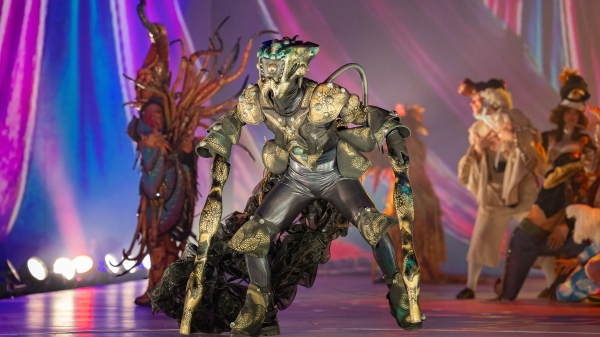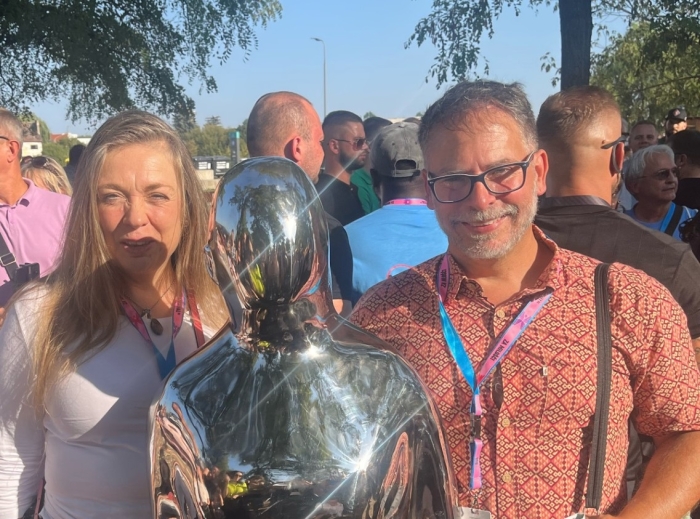Honors faculty member explains the significance of witches and Halloween

Photo courtesy of iStock/Getty Images
Scary witch or seductive witch, bad witch or good witch. No matter which witch, they’re all a favorite part of the Halloween tradition.
“Witches are popular around Halloween simply because all things spooky are associated with Halloween, and witches are spooky,” but they’re also a symbol of feminine power, said Michael Ostling, a teaching professor in Barrett, The Honors College at Arizona State University and an expert on the history of witchcraft, magic and superstition.
Ostling is the author of a book titled "Between the Devil and the Host: Imagining Witchcraft in Early Modern Poland," based on his decades of research into witch trials in Poland from the 16th to the 17th centuries, recently published in paperback. He also is editor of "Magic, Ritual, and Witchcraft," a peer-reviewed scholarly journal of witchcraft and magic studies.
Last September, at the Malta Festival in Poland, Ostling appeared on a panel exploring the history of witches and practitioners of magic and how they are perceived across different cultures and eras.
Ostling's book examines how ordinary women accused of being witches in premodern times were coerced into confessing heinous crimes, and it looks at the connections between accused witches’ Christian faith and witchcraft. It also tells women’s stories from their point of view based on careful reading of their confessions.
Before the 19th century, “we hear lots of talk about women, lots of representation of women by men, often quite negative or idealized. Women are either angels put up on a pedestal, or they are described as deviant or hysterical or emotional or out of control,” Ostling said.
“How do we know what women were really like? Well, weirdly, one of the places we can find out about that is through witch trials,” he said, explaining that when a woman was accused of witchcraft, she was brought before a court, questioned and often tortured into confessing things she didn’t do, like flying on a broomstick, having relations with the devil or sacrificing children to the devil.
“If you read the confessions or testimony of accused witches, you become aware that they are trying to defend themselves against crimes they didn’t commit, and you can learn a lot about their actual lives and personalities.”
In the spirit of Halloween, ASU News asked Ostling for more insight into his book, the holiday and witches. Here’s what he had to say.
Question: In researching your book, what did you find out about the lives of women accused of being witches in Poland?
Answer: None of the accused witches in any sense could be described truthfully as evil women. They were very everyday women. They could have been you, or your sister, or your aunt, or your mother, or your daughter. They were unique in the sense that every human being is unique, but they weren’t especially wise, or especially strong, or especially outspoken, or rebellious, or anything else. They were just women of the time who got caught up in the process of suspicion and ended up being accused of witchcraft. But before that accusation, they were just ordinary women who, instead of having claims made about them, should have been celebrated in all their ordinariness and humanity.
Q: How do you hope scholars use your book?
A: My book is just one in a really large and thriving discipline of witchcraft and magic studies. I wouldn't say that our field is unified around a single purpose. But I would say that, in my book and in similar books by other people, a lot of what we're trying to do is celebrate the contemporary reclaiming of the witch image in all kinds of ways.
For example, there's an organization called WITCH, a Portland, Oregon-based activist group that works on issues around Indigenous rights, the environment, Black Lives Matter, reproductive rights and the rights of LGBTQ+ people, and they are using the witch image. They wear witch hats — the straight-up, stereotypical, pointed witch hat — when they go to protests. They are mobilizing the energy of the idea of the scary witch.
Also, to honor the truth of the dead people I have studied, in my opinion, means to represent them as accurately as I can as humans. And so, I think that a big part of what I hope for in this book is to get those human stories out there.
Q: You say some women are seen as stereotyped versions of witches. What are those stereotypes?
A: I would say there are two modern stereotypes of the witch. There’s the one based on the Wicked Witch of the West from “The Wizard of Oz,” a 20th-century version of the modern stereotype of the witch. She is pure evil; she is scary; she wants to hurt people, especially children.
That stereotype is still with us, and we see that when, in recent years, powerful women running for office have been called witches. We've seen this with Hillary Clinton in 2016. We've already seen a little bit of this with Kamala Harris this year. So attaching that word "witch" to anyone, but usually to a powerful woman, is labeling them with this image of evil danger. It’s a frightening image.
The second stereotype of the witch, which has grown up in the last 50 years with modern feminism and the rise of various forms of neo-paganism or pagan witchcraft, is the reclaimed image of the witch as a wise woman who uses her power for good. She has knowledge and knows how to help and heal people.
Q: What is the history of Halloween and other holidays that evoke spooky images or honor the dead?
A: Halloween is one of a family of holidays — Halloween, All Hallows Eve and the Day of the Dead/Día de los Muertos — celebrated in different ways across Europe and the Americas and having, as their common root, a focus on the dead/departed.
These holidays have a complicated history, combining pre-Christian or non-Christian elements of ancestor veneration — for example, Aztec traditions in Día de Los Muertos, Irish traditions in Halloween and Slavic traditions in eastern Europe — with Catholic traditions about dead souls in purgatory. That combination results in a main feature of these holidays being depictions of the dead, often in ways that combine playfulness and solemnity. So one gets the beautifully face-painted skeletal "la Catarina" figures in Día de Los Muertos, or the classic ghost costume of trick-or-treaters on Halloween. When a child dresses up as a ghost and goes from house to house asking for candy, they are ritually embodying a dead ancestor, returned from the afterlife and demanding veneration in the form of treats.
By extension with the dead, as Halloween became more of a secular holiday in early 20th-century America, one started to see trick-or-treaters dressed as other kinds of dead people, especially influenced by Hollywood: zombies, Frankenstein's monster and mummies. By extension, again, any sort of other-than-human or extra-human being became common, even if not "dead," such as werewolves and devils, monsters of various sorts, and witches — who, after all, according to classic folklore, are human beings who interact with the dead, with demons and with monsters.
Q: How has the history of Halloween changed over the years, with the witch image becoming more prevalent as a feminist symbol?
A: In the past 30 years or so, Halloween has become a fully secular party holiday, especially among college students and in the LGBTQ+ community. Many costumes now no longer have any relation to the dead, but they retain a focus on "the other" — the different, the fantasy. If "come as you are" is a popular dress code for parties the rest of the year, "come as you aren't" is the slogan for Halloween parties. It is a chance to try out new identities in a playful way. So we get lots of sexy witch and sexy devil costumes, for example, as well as many people dressing in drag for the first time, or letting loose their inner monster.
As the image of the witch gets reclaimed by contemporary feminists as a symbol of female power — of a celebrated female dangerousness — this all gets more complicated. Alongside the traditional witch costumes, mostly based on the Wicked Witch of the West from “The Wizard of Oz,” and alongside the objectified sexy witch costumes, you now find people of all genders dressing as witches as a way to feel powerful, scary and enchanting, all at once.
More Arts, humanities and education

ASU alumna makes her way back to the ASU Gammage stage for '¡azúcar!'
As the Los Angeles-based CONTRA-TIEMPO dance group prepares for its upcoming production “¡azúcar!” at ASU Gammage, for one member of the dance group it is also a nostalgic return to her home.Born in…

ASU FIDM professor wins international award for fantastical, sustainable creation
The horror of an ailing Earth inspired an Arizona State University fashion professor to create a fantastical garment out of sustainable, re-used and found materials that won a prestigious…

ASU workshop trains educators, professionals from marginalized communities in disaster science
As devastating as hurricanes can be to anyone caught in their paths, they strike marginalized communities even harder.To address this issue, a fund named for a former Arizona State University…

